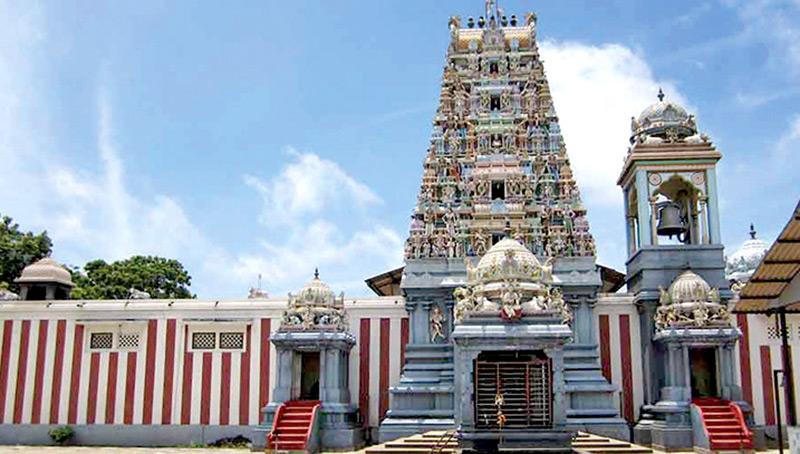
After extensive renovation work the consecration ceremony or the Kumbha Abhisekam took place at the renowned Thiruketheeswaram temple recently. The renovation work was completed a few years ago with the monetary help of nearly Rs 400 million given as a grant by the Indian Government.
The Thiruketheeswaram temple is situated on the outskirts of Mannar on the banks of Palavi tank and estuary of the Aruvi Aru (Malwathu Oya). Thiruketheeswaram was known as Manthotam or Manthai which was a port city. The temple in Manthai is one of the most important shrines for Sri Lankan Hindus. It is also one of the most ancient Saiva temples of the island.
Present temple
The present temple is located a few meters away from the original site. According to archaeological sources, the present temple is the second shrine, the first being destroyed by the Portuguese. They had removed the stones to build their forts and churches. The temple has great social, religious and cultural significance to Hindus. According to the Thevaram hymns, Mathotam was one time surrounded by lush greenery contrasted beautifully with deep blue sky and fluffy white clouds.
The temple has lain in ruins during the Portuguese period. It was later renovated and enlarged by merchants and devotees. Thiruketheeswaram is one of the Pancha Ishwarams and is venerated by Saivites in Sri Lanka and Tamil Nadu.
According to literary sources, during the post classical period (300 BC -1500 AD) the temple had been maintained by the kings of Pallava, Pnadyan and Chola dynasties who contributed to its development up to the late 16th century. In 1585, Thiruketheeswaram was razed to the ground putting an end to the rituals and daily pujas. On an appeal by Srila Sri Arumugam Navalar the temple was rebuilt in 1903 with the contribution of an Indian Tamil Chettiar R.R. Palaniappan and Hindu devotees. The credit of restoration should also go to the people of Manthai, mainly the Kariyar community.
Thiruketheeswram temple and the waters of the Palavi tank have been mentioned in the Saiva work Tevaram in the 6th century by Saint Sambandar. According to Ramayana, Mandothari, the queen of Ravana was from Manthai. Her father Mayan and the king of Manthai built the ancient temple at Thiruketheeswaram to worship God Siva. King Ravana and Mandothari were great Siva devotees. The celebrated historian Paul Peiris says Thiruketheeswaram was one of the five Eswarams of Siva in Lanka long before the arrival of Vijaya in 600 BC. However, the Mahavamsa says Vijaya built Eswarams at four corners of the island as guardian deities. The five ancient Eswarams of Lord Siva include Thiruketheeswaram, Koneswaram (Trincomalee), Naguleswaram (Keerimalai in Jaffna), Tenawaram (Matara) and Munneswaram (Chilaw).
Origin and myths
Prof. S. Pathmanathan said, “The origin and myths relating to Thiruketheeswaram are not elaborated in any literary work. There are only stray allusions about the antiquity of the temple in the Thirumalai, the large compendium of Saiva sacred literature in Tamil.” In the Datavamsa, a chronicle of the Sacred Tooth Relic of the Buddha, there is a reference to a Hindu temple at Mahatitta (Mathotam) which flourished during the reign of Meghavanna Abhaya (303-331). It is said Prince Kalinga and his sister had come to Lanka with the Sacred Tooth Relic of the Buddha and stayed at the temple on their way to Anuradhapura.
The site of the temple was put up for sale on December 13, 1893 at the Jaffna Kachcheri and it was bought by R.R. Palaniyappa Chettiar, T.M. Pasupathy Chettiar and the residents of Vidataltivu had cleared the site. A small temple had been built and it was consecrated for worship in 1903 by N. Kumarasami Diksitar. The maintenance of the temple was given to the Nagarattar community, traders of Tamil Nadu. A special consecration ceremony was performed annually in commemoration of the Kumbha Abhisekam of 1903.
This is a dream come true to the millions of Hindus in Sri Lanka.
The writer is a freelance journalist and Indologist based in Hyderabad, India.
